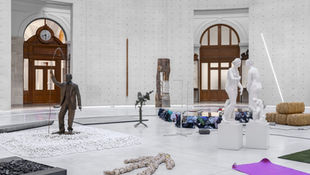
Craft and Post-War Reconstruction of Italian Design
The mythology surrounding Italian design often hinges on a triumphant narrative of post-war industrialisation and modernisation. Within this framework, designers are celebrated as visionary figures who brought order, logic, and international prestige to the Italian economy. However, this narrative tends to obscure the persistent and dynamic presence of artisanal production. Far from being an anachronism or a quaint relic, craftsmanship remained deeply entangled with Italian design culture, serving both practical and symbolic functions. The dual presence of industrial designers and artisans in post-war Italy raises important questions. Did craft obstruct or enable innovation? How did it shape Italy’s identity on the global design stage? And why has the historiography of Italian design failed to integrate these dual forces adequately?

Catharine Rossi’s Crafting Design in Italy marks a pivotal intervention in this regard. By historicizing the integration of craft and design from the late 1940s to the early 1980s, Rossi not only recovers neglected figures and practices but also challenges the binary logic of industrial modernism versus artisanal tradition. Following the devastation of World War II, Italy faced immense material shortages and infrastructural disarray. This period of crisis, paradoxically, became fertile ground for experimentation and reinvention. With limited access to large-scale industrial production, many architects and designers turned to artisanal methods, not out of nostalgia but out of necessity.
Figures such as Gio Ponti, Achille Castiglioni, and Marco Zanuso worked closely with skilled craftspeople, often in family-run workshops or small-scale studios. This collaboration allowed for a unique hybridisation of modernist aesthetics with traditional techniques. It also provided a model of localised production that contrasted sharply with the anonymous, mass-produced objects emblematic of international modernism. Craft was not only a technical asset but also a cultural and political resource. In a country still grappling with its Fascist past, the valorisation of regional craftsmanship functioned as a form of democratic and decentralised identity-making. Craft became a means of articulating Italian distinctiveness, both within Europe and in emerging global markets.
As Italy entered the period of economic boom in the 1950s and 1960s, the pressure to conform to international standards of industrial production intensified. Companies like Olivetti and Fiat epitomised this modernist, corporate design culture. Yet, even within this industrial context, designers often sought to retain artisanal values. Rossi documents how many key actors in Italian design continued to collaborate with craftspeople to produce limited editions or prototypes. These objects often blurred the boundaries between art, craft, and design, and were positioned in opposition to the uniformity of industrial production. For example, the radical design movements of the late 1960s and 1970s - such as Archizoom, Superstudio, and Studio Alchimia - explicitly critiqued industrial rationality. Their work embraced handcrafting, bricolage, and expressive forms as strategies of aesthetic and ideological resistance.
Here, craft was no longer simply a historical residue but a conscious counter-strategy. It enabled Italian designers to differentiate themselves in a saturated global market by offering products that were not only functional but also embodied cultural meaning and artistic authorship. Rossi’s analysis thus positions craft as both a medium and a message - a tool for constructing Italy’s brand of “design excellence.”

One of the more progressive dimensions of Rossi’s work is her attention to gender. Building on earlier scholarship by Penny Sparke and Anty Pansera, she investigates how the domains of craft and domestic design were often feminised, and thus marginalised within design history. Women designers, such as Gae Aulenti, Cini Boeri, and Nanda Vigo, often engaged with materials and forms that were considered “decorative” or “soft” - terms frequently aligned with craft and implicitly devalued within the male-dominated discourse of modernism. Rossi argues that by reclaiming craft as a site of critical and creative agency, these designers challenged both aesthetic and gender norms. Their work complicates the dichotomy between functionalism and ornament, between rational design and emotional labour. This re-inscription of craft into Italian design history is therefore also a feminist gesture - an effort to broaden the scope of what counts as legitimate design practice.
Why has the role of craft been so under-explored in mainstream accounts of Italian design? Rossi suggests that part of the reason lies in the historiographical alignment between design and modernist progress. Influential narratives have privileged innovation, abstraction, and industrial reproducibility - qualities that seem antithetical to the handmade, the local, and the irregular. Moreover, Italian design has often been historicized through star figures - Ponti, Castiglioni, Sottsass - whose affiliations with high-profile companies and institutions obscured the collaborative and material dimensions of their practice. Rossi’s archival and ethnographic approach, by contrast, emphasises networks, workshops, and materials. It foregrounds the infrastructural and socio-economic conditions that enabled design to flourish in Italy, not just the vision of individual designers but the skilled labour and cultural traditions that underpinned their work.
Rather than viewing craft as a holdover from a pre-industrial past or a romantic counterpoint to modernity, Rossi’s Crafting Design in Italy insists on understanding craft as a constitutive element of Italian design culture. Craft does not merely coexist with industrial design; it shapes its forms, mediates its processes, and inflects its meanings. It is, in short, integral to the story of Italian design. By focusing on the period from the late 1940s to the early 1980s, Rossi captures a critical moment in which Italy negotiated its transition from war-torn recovery to international design powerhouse. Her work challenges us to rethink the categories of design history, to attend more closely to the material cultures of production, and to recognise the value of hybridity and collaboration in creative practice. In reassessing the role of craft, we also gain a more nuanced and inclusive understanding of design itself - not as a linear progression toward industrial rationality, but as a multifaceted and ongoing negotiation between tradition and innovation, between the handmade and the manufactured, between the individual and the collective.





